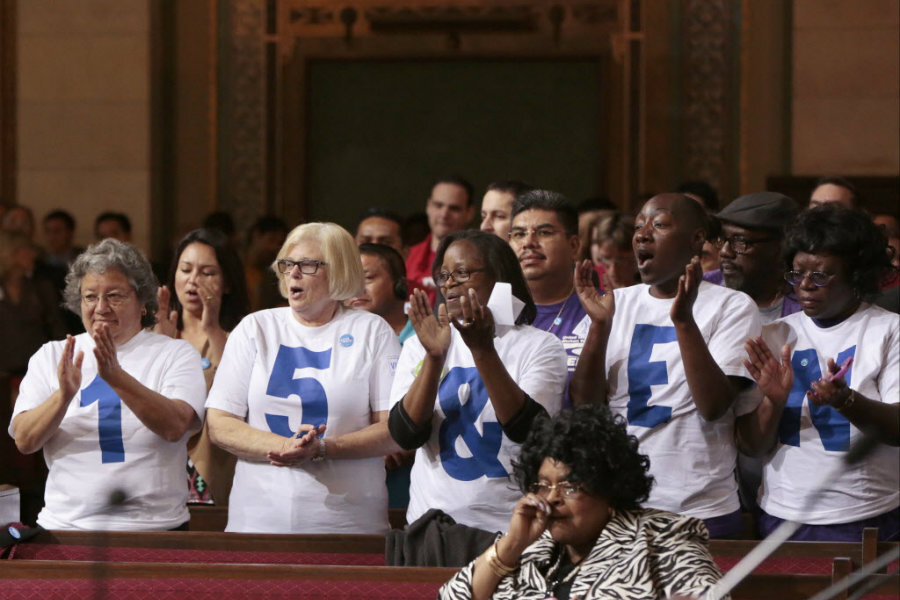Is the $15-an-hour minimum wage here to stay?
Loading...
The $15 minimum wage has made it to Hollywood.
The Los Angeles City council on Tuesday overwhelmingly voted to raise the city’s minimum wage to $15 by 2020, making it the latest and largest US metropolis to back a boost in pay for its lowest-income workers.
The decision, which comes as the nationwide debate about the costs and benefits of raising the minimum wage heats up along political party lines, may also herald the start of a shift in public perception around those on the lowest rung of employment — a change that reflects a shrinking middle class increasingly turning to part-time and low-wage jobs to replace full-time employment.
Though low-wage industries represented only about 20 percent of job losses during the recession, they accounted for more than 40 percent of recent employment growth, according to the National Employment Law Project. Conversely, mid- and high-wage industries accounted for more job losses during the recession than they have growth in the last few years.
For many workers across America, this has led to a new reality in which low-wage jobs are the norm, and people are forced to stay for longer periods in positions that were once viewed only as steps to stability.
In Detroit, for instance, where James Robertson made national headlines in February for his 21-mile hike to an $11-an-hour job as a plastic molding operator, local experts say that his commute was shocking — but his wages were not.
“Factory jobs no longer represent a guaranteed ladder to economic vitality,” USA Today reported. “Many companies have even stopped hiring full time and are relying more on temporary workers who do not necessarily receive benefits.”
It’s a reality that is as true in California as it is in Michigan. In the Lake Balboa district of Los Angeles, for example, Valerie Colter has worked as a transcriber, a cashier, a post-production assistant, and a coordinator at a captioning company since losing her job in 2005, the LA Times reported. She earned less in 2014 than she did at her first job out of college.
With this changing employment landscape comes a slow shift in perspective, as Americans come to terms with what this brand of economic recovery means for them, says Sherle Schwenninger, director of the economic growth program at the Washington, D.C.-based New America Foundation.
“Improvement in the larger employment picture has not brought higher income or job security,” he says. “The anxiety about being able to locate jobs that allow for economic security and stable income feeds into overall sentiment about raising the minimum wage.”
But while a wage hike may help bridge the disconnect between the national job numbers and Americans’ personal experience and satisfaction, Mr. Schwenninger adds, it alone is not enough to address the bigger issue: Fewer jobs that pay at levels that support a middle-class standard of living.
Tackling that problem, he says, will require significant investment in infrastructure and energy, and improvements in wage subsidies — things that need the kind of political will and cooperation not present in government today, Schwenninger notes.
Case in point: Los Angeles, where the vote to implement the wage hikes won by 14 to 1. The single opposing vote came from the council’s only Republican, Mitchell Englander.
And even after the vote, voices on both sides of the debate came loud and clear, some calling the wage hike a victory while others warned it was going to harm the people it promises to help.
Still, there are those who have voiced caution, acknowledging that raising the minimum wage is not a long-term solution.
“This is an experiment,” Councilman Paul Koretz told the LA Times. “If anyone tells you they know exactly how this is going to go … they’re not being honest with you.”






